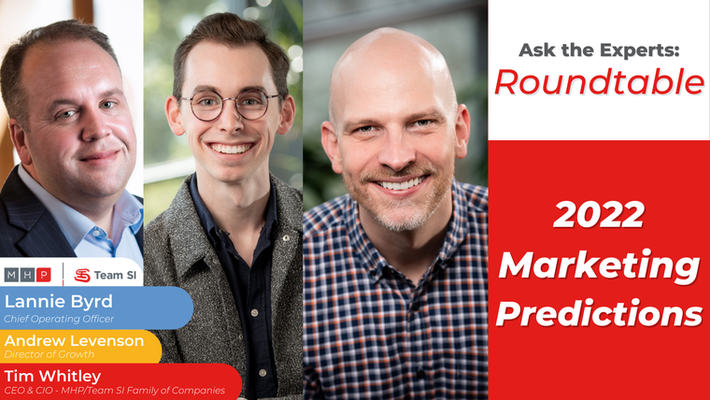
CEO of Team SI, Tim Whitley, leads a discussion with Andrew Levenson (Director of Growth) and Lannie Byrd (COO and Tradigital™ Marketing Expert) to talk about marketing trends and forecasting trends in the coming year of 2022. There’s a lot of discussion surrounding the coming year due to the fact that there have been so many changes, such as the cookieless world, audience types (where first party has started taking over), the COVID effect, et cetera. Here are a few of their thoughts and marketing predictions.
Live shopping is a trend that, for the past year, has really taken off in the US. Live shopping takes a model that’s been around for a long time, like QVC and shopping through a television, and ties it in with e-commerce. So, users on social media platforms can watch a video where products are displayed and promoted throughout. Then they can actually purchase them right away.
A lot of times, it has some sort of engagement aspect. So, if you’re watching a video, someone can talk about the features and the benefits of the product, and then you can comment or engage with the video, or you can purchase it. Even TikTok has shoppable videos now, where you can purchase it from within the video that you’re watching. So it’s really about making that process as smooth and as seamless as possible, while not making them leave that video or go to another platform.
And, with this, comes an opportunity for a bricks and clicks version of live shopping and personalization. For example, Amazon’s version of live shopping stops in browser, but with Walmart, they could actually put products in front of customers that they could then go pick up that day, taking them from the browser/app into the store. Even better, an outlet mall could have a list of live shopping events that could be at the mall. The customer could be on the phone live shopping, and seeing different products and specials in the mall that day. Bricks and clicks would take the e-commerce side and combine it with actually being there and getting the specials from live shopping. There are a lot of opportunities to merge the two, in-person and e-commerce, through live shopping.
The lines between marketing and operations, or sales, are being blurred because consumers want convenience. So, when they see the product, they want to be able to purchase it, and they want to be able to purchase it where they are. Consumers are wanting a convenient purchasing process, and wanting marketers and companies to meet them where they’re at in terms of “I want to purchase now, I want to purchase here. I don’t want to go into a store.” It blends the marketing, and the sales, and the operations. You have to have the capabilities and the infrastructure set up to be able to offer those kinds of features and functionality that consumers are wanting.
The concept of audiences, and who we’re targeting, touches every campaign we’re doing and every type of work we’re doing. From developing personas, to actually where we’re targeting our media. The audiences start with first party data. And it’s that consumer buying data where we deep dive into our client’s data warehouses, and understand which ones are the people that make the best purchases.
But, we also have a secondary audience. And this consists of things like looking for “families over 50”. So how do we develop messages around those audiences to target them? What kind of media channels do we use? Where are we placing the ads? What kind of data are we using? How do we target that household, rather than consumer behaviors? New methodologies that navigate the cookieless world are coming out to target these unique audiences. The elimination of 3rd party cookies has generated new opportunities and new ways to target and identify those people and audiences.
We have seen a decline in third party audiences just in the yeas of FY 2020 and 2021. The available third party data assets globally went from about 560,000 to 62,000. That may sound like a big jump, and it is if you break it down. Third party audiences have kind of been streamlined. They aren’t as specific and granular, but are almost more generalized in a way.
The original version of this page was published at: https://mhpteamsi.com/news/marketing-predictions-for-2022-ask-the-experts/
For more than 40 years, MHP/Team SI has worked with hospitals, colleges and universities, nonprofit organizations, Fortune 500 companies, and government agencies to build their brands, increase pub... Read more
As the fallout from the coronavirus pandemic continues to be realized, telemedicine has become a critical service for many health care organizations. While it is intended to be a convenient ...read more
In the world of healthcare marketing, COVID-19 changed the world for everyone. Almost two years into the pandemic, we are all hopeful that the world will be back to “normal” ...read more
It’s already time to begin thinking about 2023. Here at MHP/Team SI, we’ve gathered our experts to make their 2023 marketing predictions. We’ve been doing this for ...read more
As marketers, it’s incredibly important to make sure your audience feels seen, understood and accurately represented. Diversity and inclusion should be kept in mind when it comes ...read more